|
|
Luna: Living Large and At Large
by Dave Zeiger and Anke Wagner
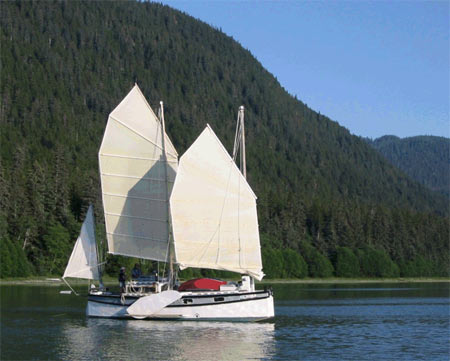
1997. Y2K is looming with the whole 21st century right on its heels (now, don’t you know a lot
about us, already?). Our choice of lifestyle is to be footloose and subsistant in S.E. Alaska, blow
high, blow low. So what we want is a live-aboard ‘boogie bag’ of a boat. It’s got to carry our
gear and books, handle anything from flat calms to howling gales to the collapse of civilization
as we know it, and be built, maintained and operated on a relative shoestring.
Do you think it’s coincidence that it was Ken Neumeyer’s Sailing the Farm: A Guide to
Homesteading the Ocean – Independence on 31 Feet, that opened our eyes to actually living
aboard?
Luna’s hull is our interpretation of Phil Bolger’s Advanced Sharpie (AS) 29. At 31' x 8' x 13"
and 8300 lbs displacement, she is slightly larger, foregoing trailerability and 30' slips for greater
interior volume and displacement. Quick and cheap to build from sheet and dimensional
materials, these ultra-shoal boats sail well, take the ground upright, are positively buoyant, selfrighting,
dry-bilged and rugged. Their Bang/Buck ratio is top ‘o the charts. And, as Tristan
Jones observed, a sailboat is the only vehicle with unlimited range.
We found ourselves in Tenakee Springs (pop. 60ish) at the leading edge of Summer...
Through a friend’s generosity, we had a roofed area for a shop, alongside which we could build
the boat. The footing was about 5 feet of wood chips, which proved to be A Complication. After
a week laying out and cutting bulkheads and hull panels, we framed the bulkheads and started
the bottom, upside down. A good chunk of the town came to help turn ‘er over... even blind
‘Grampa Darrell’, who allowed his approval after a thorough tactile examination.
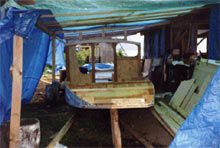 From there we built up...
From there we built up... |
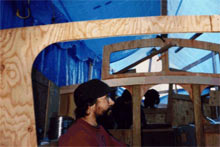
...and up.
|
|
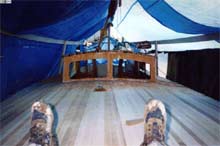 ‘Strip-planked’ Deck.
‘Strip-planked’ Deck.
|
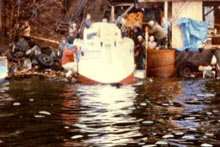
A glorious Tenakee launch! |
|
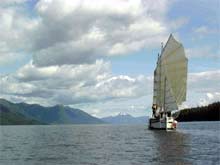 Next thing ya know, we’re sailing away!
Next thing ya know, we’re sailing away!
(click this picture for larger version) |
|
Ok... so I’m glossing over a few stories, some of which are the kind that give boat building a bad
name (if you don’t have a developed sense of humor). We started 7 June and launched
29 November of ‘97. The interior was only roughed in, unpainted and without heat. Of course
we moved aboard! Cash flow (the high viscosity variety) meant the bottom was copper-plated
after launching (a tale unto itself). We were sewing the sails as Y2K arrived in the Kiribatis.
Life intervened, Death intervened. The usual. Cat yawl in Spring of 2000, schooner by Autumn.
Overall we figure that we’ve got just over a year of work and $12,500 in her ($4000 of that for
2000 lbs of copper plate, and about 20% is markup for building in rural Alaska).
But now the real fun begins. Text in italics is Anke writing...
We had our troubles building remote, but the compensation was the input of the community and
the generous offers of resources and the lending of hands and moral support.
Luna has no engine. We either sail, scull with a yuloh (1.5 knots at an all-day pace), pole
ourselves in shallows or warp. Some days we make 80 miles, some we make 5 or less. We try
not to have a schedule, and so find the time to poke around interesting looking ‘holes-in-thewalls’...
secluded bays, shallow river deltas, narrow passageways through reefs... If we like a
place, we stay a while.
One of my favorite memories is of a period of summertime Dave and I sailed up the Kadashan
River. The wind was just right this time to blow us up the shallow river as far as depth allowed.
We tried to keep to the middle (in the straightaways) and keep a lookout for gravel bars. In the
bends, we hugged the cut-banks where the current had dredged deeper passageways. Sometimes
we ran aground. Dave would jump off the boat and Scups (our dog) and I put our weight on the
opposite side until he wrestled us free. We finally anchored in mid-stream.
Next morning, with coffee on the woodstove, I felt watched and looked up and through the
pilothouse /galley windows. On the bank above me, about ten feet away, were three pairs of big
brown eyes looking at me. It took me a split second to realize they were deer, a doe and two
fauns, moving their heads curiously up and down, their nostrils trying to get a whiff of us to
determine what we were.
Usually it takes a couple of days before you see many of the resident wildlife. Then they seem to
get used to you and show themselves frequently as they go about their daily routines. Pretty
soon you can figure out where and when you’ll see them. Often, too, it seems that we can watch
animals particularly well from the boat. They don’t seem to expect any danger coming from the
water or shore.
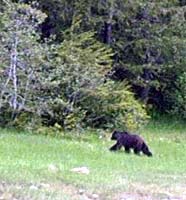
One of our Neighbors, passing through...
shot through our window... we’re dried
out in the foreground. |
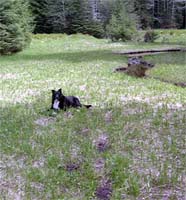
Scups on a bear trail... for some reason,
bears tread in the same foot steps for
generations... these are about 8" deep.
|
|
We went for long walks on the tidal flats, swam and fished in the river and picnicked in the tall
grass. We didn’t wear a stitch of clothing in all those hot, secluded days.
One autumn night on the same flats, we were poling in flat calm on a rising tide. A glorious
sunset had given way to brilliant stars. Most nights of this sort are luminously quiet. One hears
only the sound of the pole or yuloh, or the breath of seals, sea lions or whales. This night though,
we approached a joyous and mounting caucaphony. Flocks of geese, ducks, gulls, swans sang,
whooped, screamed and whistled through the night. Herons punctuated the din with ‘RAAWKS’
of prehistoric annoyance. Anchored and on deck, we shared a blanket and a glass of wine. By
morning they were gone, all but the faithful gulls.
The junk sails are identical (ergo exchangeable), and the rig may be used in cat yawl or schooner
mode. With the foresail sheeted in and the main set free, we can sail a tortuous path (as in, ‘up
the river’) without touching the sheets (beating as cat yawl into the wind, running and reaching
under the main). Handy getting into or out of tight spots. Twin leeboards (technically, they’re
‘off-centerboards’) are kept from winging out on the windward side, so there’s no need to tend
them between tacks. With no jibs, ditto for the three sails. Sails and boards are handled from the
cockpit. To reef, simply lower the haulyards as desired, sheet in, sail on. Low tech, low cost,
low stress.
S.E. Alaska is often considered ‘inhospitable’. But forage is plentiful. We gather double the
amount of greens we eat, spring through autumn, drying half for winter. Venison is plentiful as
are fish, crabs and molluscs. With no refrigerator, we target small rock cod. Two is enough for
dinner with some left over for breakfast. We have a pressure cooker and canning supplies, but so
far haven’t started up that particular learning curve. Sea algeas (‘seaweeds’) are year-round
greens and delicious prepared in any number of ways. Wood for cooking and heating, well...
grows on trees. Carbohydrates are harder to come by... we’re still buying grains and legumes and
potatoes. The latter were once grown in patches along beaches by hand-trolling fishermen,
something we’d like to try. Chocolate, I’m afraid, is going to keep us tied to the cash economy.
Many long stretches are rocky and steep and, as one friend puts it, “the wind can come stompin’
down with his Long Boots on!” Luna’s shoal draft and heavily shod bottom allow us to get out
of the stomp zone, usually within a mile of anywhere. We can run up a beach or creek or duck
into shoal lees, while deeper boats must fight their way to distant shelter. If a big storm is
coming, we often get concerned inquiries from folks disturbed to see a boat sitting in a patch of
beach grass 20 feet above the water (tide ranges up to 24 feet).
There’s a certain amount of physical effort to the lifestyle we’re growing into, devoid, as it is, of
internal combustion enginery. I have a theory there’s just enough of it to keep us fit and healthy.
Most of our time is given over to the lassitude we so enjoy. Our pace is set by wind, water and
muscle. Our days are free for friends. For gastronomy. For books and music and drawing and
spoonin’ and dreaming and drifting into tune with that whole, incredible world around us.
We’ll be watching for your sails!
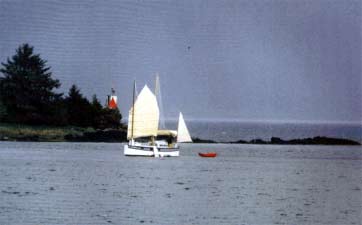
Scooting out of a gale in Yawl Mode. |
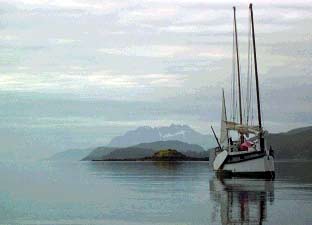
Quiet anchorage in Paradise. |
|
P.S. You can check in on us at www.triloboats.com
(Follow the ‘About Us’ link).
|
|
|

